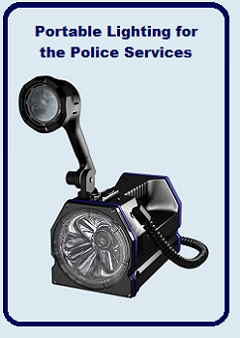White Knight has been manufacturing rechargeable handlamps since1976.
They started with the ‘White Knight’ range of handlamps and later the White Knight Halo Plus Personal Signalling Lamps, professional halogen torches.
Halo Plus 2 Halogen Torch
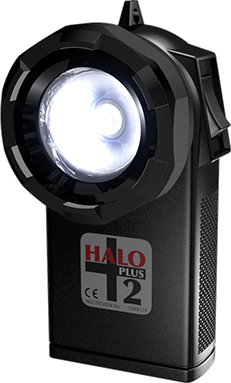 Halo Plus 2 Halogen Torch by White Knight – halogen torches designed and built to service the needs of both the professional services and industry:
Halo Plus 2 Halogen Torch by White Knight – halogen torches designed and built to service the needs of both the professional services and industry:
Compact for hand held daily use. Tough, highly flexible belt clip for hands-free operation
Ruggedly moulded in high impact plastic to withstand the toughest of conditions
High and low beam function with a unique interchangeable battery cassette for use with standard alkaline ‘C’ cells, or rechargeable Ni-Cd and Ni-MH batteries. The Halo Plus HP-2 Range of Personal Signalling Lamps features the latest advances in LED Technology. Each lamp features a high performance super bright LED Array in up to three colour combinations – red, green, blue, yellow and white. All colours conform to BS 1376 signal colours. Specialist colour requirements can be met.
The Halo Plus 2 lamp has been in production since 1990. It is used by the British, German and Swiss rail networks, as well as the Eurostar service and infrastructure companies.
Network Rail Approved Cert. No. PA/05/965
±7.5° viewing angleCan be viewed in sunlight
Long operational life – typically 60,000 hours
Each colour has 7 LED x 360° array
Coloured changeover switches
Long life fully protected Halogen Bulb
Robust weatherproof mouldings giving high mechanical strength
High resistance to shock and vibration
Halo HP-11 Signalling Lamps
 Halo HP-11 Signalling Lamps by White Knight provide guaranteed performance in non-hazardous situations, the HP-11 provides a reliable way forward for the security services and transport industries.
Halo HP-11 Signalling Lamps by White Knight provide guaranteed performance in non-hazardous situations, the HP-11 provides a reliable way forward for the security services and transport industries.
Delivers a constant 10,000 candlepower
Features a high/low beam option for use in low light applications
Interchangeable battery cassette provides 3 hours continuous light on one set of rechargeable 2.2 Ah batteries or 5 hours using standard alkaline batteries
Apart from the Network Rail approved signalling lamp used for train movement -shunting etc – White Knight also manufacture a sturdy range of lamps for other areas of the rail infrastructure including banksmans lamps, and other portable spotlights for long and short distance inspection work.
“Railway Bardic lamp” is now a generic term used to describe any portable signalling lamp that uses different colours. Although designed as signalling lamps, LED bardic lamps can be used as temporary headlights or tail lights on trains in an emergency, and most trains have a bracket for holding these lamps.
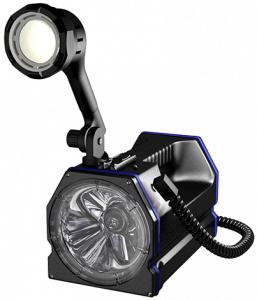 The WKA-13 fingerprint illumination lamp emits a very bright even light designed specifically for Scenes of Crime Officers and Fire Investigators. Using the WKA-5 as a power source, this lamp can be held freely or used attached directly to the hand lamp via a mounting adapter, giving hands free operation with the ability to rotate and adjust the angle of illumination.
The WKA-13 fingerprint illumination lamp emits a very bright even light designed specifically for Scenes of Crime Officers and Fire Investigators. Using the WKA-5 as a power source, this lamp can be held freely or used attached directly to the hand lamp via a mounting adapter, giving hands free operation with the ability to rotate and adjust the angle of illumination.
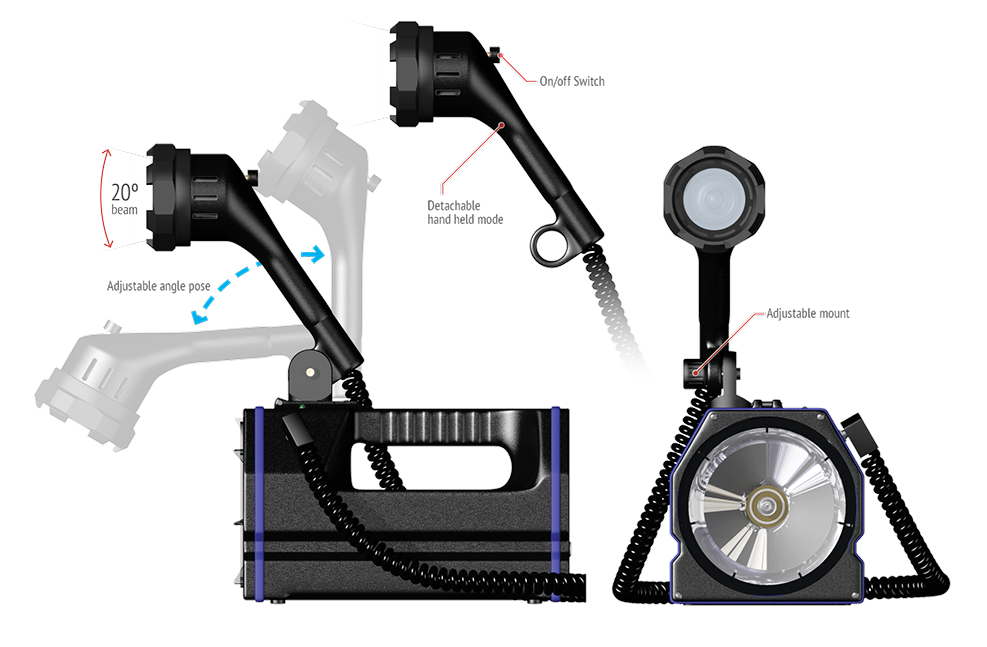
The WK13 is mounted on the versatile WK-5 which is used by police, fire and ambulance services throughout the world. It features a comprehensive choice of models 30watt, 20watt, 10watt and 6watt halogen output, providing 75 minutes to 7 hours continuous illumination
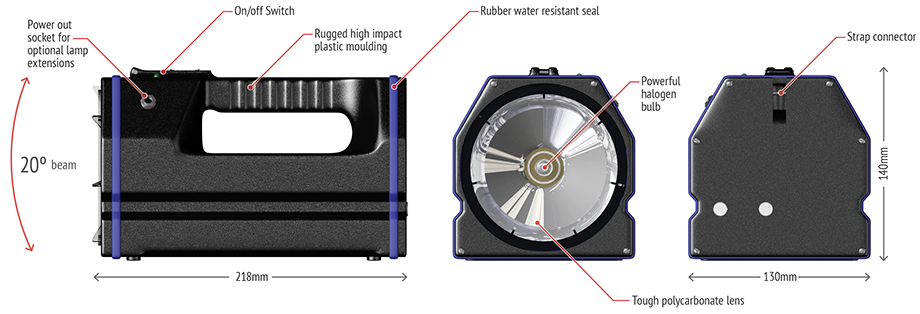
- Available with Ni-MH 6V 7Ah battery packs
- Approved for use by the MOD and NATO forces
Give us a call on +44 (0)23 9266 8624 if you need reliable, easy to use, lightweight emergency lighting for your SOCO teams.
Outside of London, Glasgow has one of the most intensive suburban railway networks in the UK, and just like their modern counterparts, rail workers in Glasgow in 1890 were fed up with working conditions and miniscule pay increases.

In those days, the majority of rail employees worked at one of three rival firms: the Caledonian, North British and Glasgow & South Western railway companies.
These companies were making huge profits as the number of Scots travelling by rail soared. At the same time working hours for rail staff was becoming intolerable. The average engine driver, signalman and shunter was working shifts of 14 to 15 hours a day. Some workers, it was found, were on shift for 20-30 hours at a stretch. In December 1890, Glasgow’s rail workers came together through their unions in what would become the largest rail strike ever witnessed in Scotland and demanded a 10-hour day.
Knowing their hand would be strengthened with Christmas fast approaching, the city’s rail workers realised it was now or never.
Picket lines were set up suddenly and without warning , on the morning of December 22, 1890. Workers in Edinburgh, Dundee and elsewhere joined the cause, sparking chaos across the country. On that first day, more than 4,500 workers abandoned their posts, with a further 5,000 joining them over the following four days. Passenger services immediately became late and irregular.
Trade was affected too, with goods traffic almost non-existent and factories across the Central Belt ceasing production due to a shortage of coal.
The tense situation reached a head at Motherwell on January 5, when the Caledonian Railway Company terminated the contracts of striking workers who had only recently taken up employment with the firm. The decision meant many young families being forcibly evicted from their homes, which had been supplied by the railway company.
Caledonian bosses said it was their legal entitlement to sack the workers – but this was an irrelevance to the men on strike and their supporters in North Lanarkshire.

Incensed by the evictions, a hostile crowd of around 20,000 assembled to make their feelings clear. Riotous scenes erupted with protesters hurling rocks and causing damage to signal boxes on the railway lines. Mounted police and military were called upon to disperse the crowd, leaving a number of people injured.
After six long weeks the rail companies agreed to improve working hours for their staff and the strike ended.
The Caledonian Railway Company also dropped all actions for damages at Motherwell Station and allowed most of the men who had been fired to return to their company homes.
We can only hope that the current rail strike reaches a rapid and acceptable conclusion for all involved – not least of all, the commuter!
The best flashlights for emergency use are ones with a long battery life and a powerful beam.
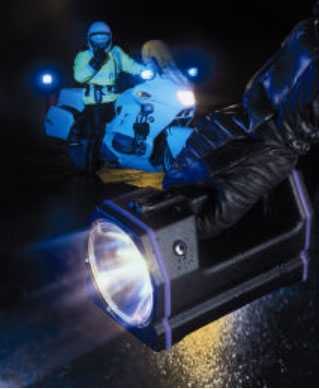 White Knight produce the Expert WK-5 Hand Lamp, is a professional halogen rechargeable handlamp.
White Knight produce the Expert WK-5 Hand Lamp, is a professional halogen rechargeable handlamp.
Made in the UK the WK-5 is used by Emergency Services and Search and Rescue organizations worldwide.
Designed for long and short distance work, the WK-5 Handlamp is a powerful torch that is moulded from high impact plastic to withstand the toughest conditions – durability that will last for years.
The Expert WK-5 range offers a comprehensive choice of models:
- 6, 10, 20 and 30 watt halogen outputs providing 55 mins to 14 hours of continuous illumination.
- High/Low and Flashing Beam Setting
- Low Battery Indicator
- Charge State Indicator
- Vehicle Battery Monitor
- Usage Monitor
- Auto Maintenance Charging
- Electronic Bulb Protection
- Mains Failure/Restore Monitor allows Expert WK-5 Trio to be used as an Emergency Portable Light Source
- Special versions using High Output LED Arrays are available for signalling purposes
- Environmentally friendly, fully protected Ni-MH Battery Pack
- Supplied complete with Mains Charger, Vehicle Charging Cord and Shoulder Strap
- Approved for use by the MOD and NATO forces.
A full range of plug-in accessories is available including: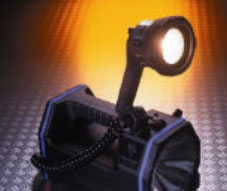
- Floodlighting
- Fingerprinting
- Ultra-violet and other lamps for forensic and close inspection use
White Knight have been producing rechargeable handlamps since 1976, and are constantly researching and developing their products.
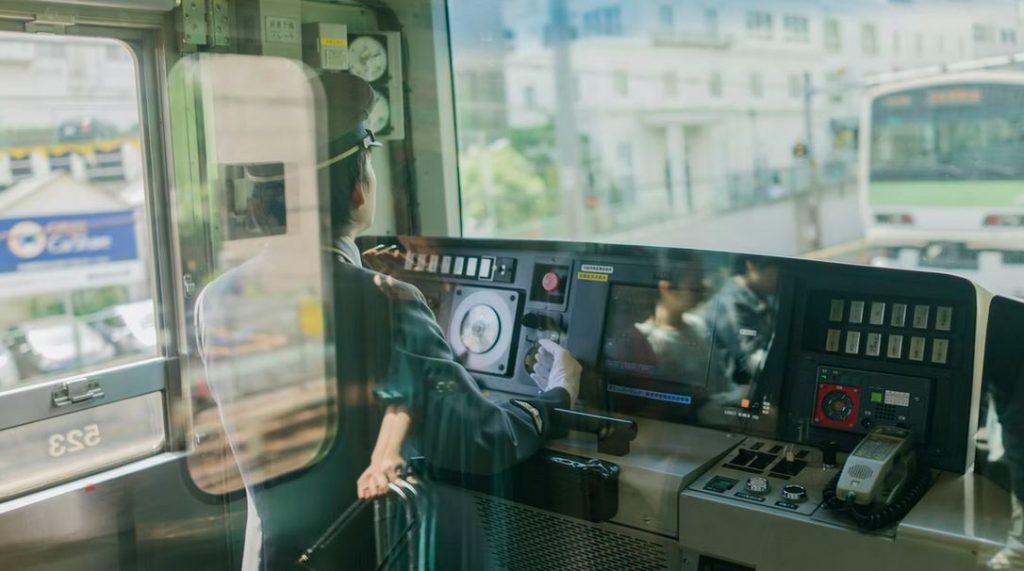
Lots of small children want to be train drivers, but what if you still want to drive trains when you’re an adult – what do you do?
How to Start
You do not require any formal qualifications to become a train driver in the UK, but applicants must be over 21 and face a host of online tests and psychometric assessments as well as a number of interviews. This process can take up to 6 months to complete. Becoming a train driver is an extremely popular profession and there can be up to 1,000 applicants for each vacancy.
Applicants will be assessed for the following skills:
- Concentration
- Observation
- Abilty to perform under pressure
- Customer service qualities
- Attention to detail
- Abiltiy to follow strict rules and safety procedures
- Equipment, computers and other device operating skills.
What Next?
Once employed as a trainee train driver it can take between 12 and 15 months to qualify, depending on the individual train operating company.
The course will consist of both practical and classroom-based exercises. Some of the areas you will be training on will be:
• Train driver rules and regulations
• Train handling
• Knowledge of traction
• Route knowledge
• Safety procedures
Apart from the training modules you will have to complete a set number of hours in the cab of a train, both accompanied and unaccompanied. These hours vary between TOCs but are usually between 200 and 255 hours.
What Do Train Drivers Earn?
One of the reasons train driver is such a popular occupation is the excellent salary.
A trainee train driver starts on about £25,000 but this increase quite dramatically to an average of around basic salary of around £48,500 pa, with some train operating companies offer well in excess of £55,000 for qualified train drivers.
Therre is the potential to earn even more in speacialist services such as Eurostar.
Before you rush off and apply for a job as a train driver, bear in mind that it is a stressful job which requires intenses concentration and also some very unsociable hours!
The best flashlights for emergency use are ones with a long battery life and a powerful beam and White Knight offer two solutions for emergency hand-held lighting.
WK-5 Hand Lamp
- Designed for long and short distance work
- A powerful torch that is moulded from high impact plastic to withstand the toughest conditions – durability that will last for years
- Used by police, fire and ambulance services throughout the world
- A comprehensive choice of models 30watt, 20watt, 10watt and 6watt halogen output
- Provides 75 minutes to 7 hours continuous illumination
- Available with Ni-MH 6V 7Ah battery packs
- Approved for use by the MOD and NATO forces

Halo Plus2™ HP-11 Personal Torch
Where guaranteed performance in non-hazardous situations is the criterion, the Halo Plus2™ provides a reliable way forward for the security services and transport industries.
- Delivers a constant 10,000 candlepower
- Up to 5 hours continuous light High / low beam option switch Interchangeable battery cassette
- Integral belt clip
- NATO Stock No. 6230 998628598

White Knight have been producing rechargeable handlamps since 1976, and are constantly researching and developing their products.

The recent visit from Storm Eunice once again made us aware of how vulnerable we are in the face of nature’s wrath. Eunice blew through the UK leaving a trail of devastation and destruction not seen for many years.
One of the hardest hit services was our rail network with all sorts of disruptions causing chaos across the country. Fallen trees, damaged power cables, damaged tracks, and debris on the lines – including trees, various items of garden furniture, trampolines and even the odd roof.
The job of clearing up and ensuring that our railways are running as safely and efficiently as possible is in the hands of Network Rail.
Their engineers and contractors maintain, repair, and improve our rail infrastructure around the clock in all weathers to make it possible for trains to run. In order to achieve this they are assisted by a fleet of seasonal track treatment machines and vehicles.
These vehicles include:
- Multipurpose vehicles (MPV)
- Snow and ice treatment trains (SITT)
The MPV and SITT both scrape ice off the conductor rail head (the top of the conductor rail) and can spray the rails with hot liquid anti-icer that prevents ice sticking to the conductor rail head.
- Winter development vehicle (WDV) used to blow hot air around the running rails – specifically around points and crossings – to melt snow and ice that is stopping the points from working. The WDV is also equipped with steam lances to melt the more built-up stubborn ice deposits.
- Snow ploughs can be fitted to the front of trains for removing snow
- Mini snow ploughs (MSPs) – owned by freight operating companies – clip on to the front of locos that are operated under contract to us, and as the name suggests, they’re the smallest of the ploughs. Their blade can be adjusted for snow depth but can’t usually cope with more than 18 inches.
- Small snow ploughs can fit to the front of passenger trains to clear up to eight inches of snow. These and our typical winter weather vehicles and procedures (see above) may not be enough to remove heavy snowfall though – that’s a job for our extreme weather fleet (our ploughs below and our snow blowers).
- SITT (plough – This can be added to the SITT (front and rear) if a significant snow fall has closed a third-rail route.
- Beilhack V plough and Independent snow plough are more robust ploughs for heavier snow
Snow blowers
Two snow blowers, based in Scotland, are fitted with propellers that cut through and blow away snow drift. A special hydraulic turntable within the machine makes it possible for the snow blower to turn around on its own if needed.
For more information read this article with some interesting pictures and videos on the Network Rail website.
 Those of us who regularly use trains will no doubt be relieved to hear that transport secretary, Grant Shapps is to review repetitive and unnecessary announcements on trains in an attempt to make train travel more attractive to commuters.
Those of us who regularly use trains will no doubt be relieved to hear that transport secretary, Grant Shapps is to review repetitive and unnecessary announcements on trains in an attempt to make train travel more attractive to commuters.
Mr. Shapps said ‘Train passengers are all too often plagued by an endless torrent of repeated and unnecessary announcements.’. He went on to say that he is ‘calling for a bonfire of the banalities to bring down the number of announcements passengers are forced to sit through and make their journey that little bit more peaceful.’
This should bring an end to the repetition of less-than vital-messaging like shoes on seats, noisy headphones, and litter in bins,” but the Department for Transport (DfT) said key safety messages would remain. So sadly, no reprieve from British Transport Police’s “most annoying slogan of the century”, “See it. Say it. Sorted”.
The DfT said it would be working closely with the Rail Delivery Group and passenger groups such as Transport Focus, as well as train operators, to identify how the “vast number” of announcements could be cut or reduced.
Commuters can now look forward to not being reminded when the food court is closing, having their tickets ready, and the most annoying of all, constant reminders that you are in a quiet carriage (where the only noise is coming from the tannoy system).
Although the government does not have the power to stop this “bonfire of banalities”, they are hoping that the rail industry will limit announcements that are not critical and prioritise a calmer environment for passengers.
Mick Lynch, general secretary of the Rail, Maritime, and Transport union (RMT), said the policy was “clearly nothing but a PR stunt by this collapsing Government”.
A number of these announcements are imposed on the train companies by the DfT, and many of them are essential for blind passengers.
The move has been welcomed by Transport Focus and the Rail Delivery Group.
We await further announcements…
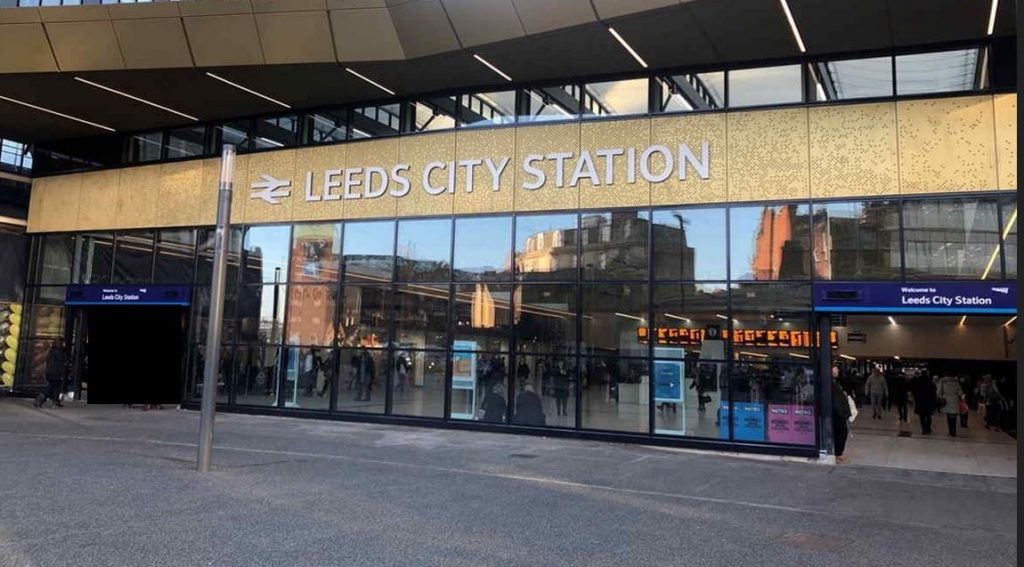
Wendy Morton, the rail minister, has praised the new £161m upgrade to Leeds station which will transform rail journeys across Yorkshire.
The Minister met with former apprentices and Network Rail staff who have helped deliver the upgrades to the Trans Pennine Route.
New tracks and longer platforms are included in the £161m upgrade which will provide passengers with more seats, services, and more punctual journeys.
The Leeds station upgrade forms part of the Government’s £96bn Integrated Rail Plan (IRP) aimed at transforming rail connections in the North and Midlands.
Speaking on the upgrade Rail Minister Wendy Morton said: “Leeds station is a major hub right at the heart of the North. It is not only a gateway to one of the UK’s most vibrant and lively cities but a vital transport link.”
She added that this would enable people from all over the country to travel for work, pleasure and connect with friends and family. These upgrades are a huge milestone and will go a long way to delivering a modern, fully connected transport hub fit for the future. Passengers should also see improvements to journey times much sooner than under previous plans with the IRP.
Councillor James Lewis said that the upgrades at Leeds station were an important milestone in the continued ambitions to modernise Leeds rail connections.
The upgrades are a first step towards beginning to address the capacity issues at Leeds station.
“We will work with the government to secure a robust strategy for ongoing enhancements to improve connectivity for Leeds that will benefit Yorkshire, the North and the UK.”
Upgrades to Leeds station were completed by engineers over the New Year break.
 Werrington Tunnel, an underground freight tunnel running beneath the East Coast Main Line near Peterborough, has been formally opened by Rail Minister Chris Heaton-Harris.
Werrington Tunnel, an underground freight tunnel running beneath the East Coast Main Line near Peterborough, has been formally opened by Rail Minister Chris Heaton-Harris.
A key step in the £1.2bn East Coast upgrade, the opening of the tunnel allows for freight services to be ran underneath the main rail artery, significantly improving passenger service reliability on the East Coast Main Line.
Easing congestion on the route will also allow the operation of more passenger trains, providing more seats between London and the North of England and Scotland.
The installation of the tunnel saw a UK engineering first, as the 11,000-tonne curved concrete tunnel was constructed alongside the East Coast Main Line in nine interconnected sections and then slid into place under the existing railway earlier this year.
At 155 metres long, 9.5 metres high and 5.1 metres high, with 1 metre thick walls, the Werrington Tunnel’s ‘concrete box’ weighs 1,000 tonnes more than the Eiffel Tower.
The tunnel was set in place in January 2021, with the new track then installed inside the tunnel in July. Work then continued to install the signalling system before vital testing of the new tunnel took place to enable trains to start using the infrastructure.
Rob McIntosh, Managing Director for Network Rail’s Eastern region, said: “From building the huge concrete tunnel onsite next to the East Coast Main Line, to pushing it into place in a UK first for engineering, to installing new track and signalling equipment to connect it to the existing lines – it’s been amazing to see the progress our teams have made on this ground-breaking project.
“Passengers travelling between London, Peterborough, the north of England and Scotland will benefit from faster, more reliable journeys as longer freight trains can now dive underneath the famous passenger route.
“I’m proud of our team’s brilliant response to the challenges of the Covid-19 pandemic and how they reached major milestones on the project when it was at its peak. Using innovative methods, we’ve also been able to avoid major disruption for passengers, as services have continued running throughout the majority of the work. We want to thank passengers as well as people in the community for their continued patience.”
Speaking as he officially opened the tunnel, Rail Minister Chris Heaton-Harris said: “This country’s railways have long been home to marvels of engineering and the new Werrington Tunnel shows that we are continuing that proud tradition.
“Opening this new section of railway marks the end of a project which saw Network Rail engineers deliver an incredible feat installing an 11,000-tonne concrete tunnel, freeing up tracks and unlocking new opportunities for rail freight.”
The completion of the Werrington Tunnel project will also help pave the way for the major infrastructure rollout planned across the North of England and Midlands, as announced in the recently released Integrated Rail Plan (IRP).
This includes £96bn worth of investment into the railways to help deliver real and meaningful improvements to communities, supporting economic growth by transforming both east-west and north-south links.


